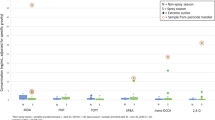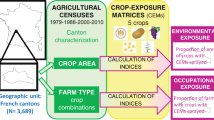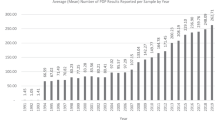Abstract
Purpose:
The Farm Family Exposure Study was initiated to characterize pesticide exposure to farm family members around the time of one pesticide application in a manner that will facilitate exposure assessment in epidemiologic studies of pesticides.
Methods:
A sample of farm families with children was recruited by randomly selecting farmers from lists of licensed pesticide applicators in Minnesota and South Carolina. Eligible families were selected from among those who planned to apply one of three chemicals, glyphosate, 2,4-D, or chlorpyrifos, as part of their normal operations. The applicator, spouse, and all children in the family ages 4–17 years were included in the study. The applicator and spouse completed self-administered questionnaires addressing demographics, farming practices and potential exposures to them and their children. Field observers documented the application, recorded application practices, equipment, potential exposures, and the presence of children or spouses in the immediate vicinity of pesticide activities. All study participants were asked to collect each urine void for 5 days, 1 day before through 3 days after the application. Pesticides were measured in 24-h composite urine samples with a one part per billion limit of detection.
Results:
Of 11,164 applicators screened, 994 families met the inclusion criteria. Of these, 95 families were enrolled. Enrollees were similar in most characteristics to their peers who were not participants in the study. In total, there were 106 applications, 10 of which involved more than one chemical. This resulted in urinary data for 48 farmers and spouses and their 79 children for glyphosate, 34 farmers and spouses and their 50 children for chlorpyrifos, and 34 farmers and spouses and their 53 children for 2,4-D. Compliance with the 24-h urine collection was particularly good for the adult participants. There were more missing samples for children than for adults, but overall compliance was high.
Conclusion:
The Farm Family Exposure Study should provide insights about pesticide exposure under real world conditions and thereby facilitate improved exposure assessment in epidemiologic studies of agricultural populations.
This is a preview of subscription content, access via your institution
Access options
Subscribe to this journal
Receive 6 print issues and online access
$259.00 per year
only $43.17 per issue
Buy this article
- Purchase on Springer Link
- Instant access to full article PDF
Prices may be subject to local taxes which are calculated during checkout
Similar content being viewed by others
References
Acquavella J., Olsen G., Cole P., Ireland B., Kaneene J., Schuman S., et al. Cancer among farmers: a meta-analysis. Ann Epidemiol 1998: 8 (1): 64–74.
Acquavella J.F., Alexander B.H., Mandel J.S., Gustin C., Baker B., Chapman P., et al. Glyphosate biomonitoring for farmers and their families: results from the Farm Family Exposure Study. Environ Health Perspect 2004: 12 (3): 321–326.
Alavanja M.C., Sandler D.P., McMaster S.B., Zahm S.H., McDonnell C.J., Lynch C.F., et al. The Agricultural Health Study. Environ Health Perspect 1996: 104 (4): 362–369.
Bingham S.A., Williams R., Cole T.J., Price C.P., and Cummings J.H. Reference values for analytes of 24-h urine collections known to be complete. Ann Clin Biochem 1988: 25: 610–619.
Blair A., and Zahm S.H. Herbicides and cancer: a review and discussion of methodologic issues. Recent Results Cancer Res 1990a: 120: 132–145.
Blair A., and Zahm S.H. Methodologic issues in exposure assessment for case–control studies of cancer and herbicides. Am J Ind Med 1990b: 18 (3): 285–293.
Blair A., and Zahm S.H. Agricultural exposures and cancer. Environ Health Perspect 1995: 8: 205–208.
Blair A., Zahm S.H., Pearce N.E., Heineman E.F., and Fraumeni J.F. Clues to cancer etiology from studies of farmers. Scand J Work Environ Health 1992: 18 (4): 209–215.
Boyle C.A., and Brann E.A. Proxy respondents and the validity of occupational and other exposure data. The Selected Cancers Cooperative Study Group. Am J Epidemiol 1992: 136 (6): 712–721.
Brown L.M., Blair A., Gibson R., Everett G.D., Cantor K.P., Schuman L.M., et al. Pesticide exposures and other agricultural risk factors for leukemia among men in Iowa and Minnesota. Cancer Res 1990: 50 (20): 6585–6591.
Brzak K. Analytical method validation for the determination of 2,4-Dichlorophenoxy acetic acid (2,4-D) and 3,5,6-Trichloro-2-pyridinol (TCP) in human urine. Dow Chemical Company. Available: http://www.farmfamilyexposure.org/AnalytMeth_24D_TCP.pdf2004, 2001.
Correa A., Stewart W.F., Yeh H.C., and Santos-Burgoa C. Exposure measurement in case-control studies: reported methods and recommendations. Epidemiol Rev 1994: 16 (1): 18–32.
Cowell J.E., Kunstman J.L., Nord P.J., Steinmetz J.R., and Wilson G.R. Validation of an analytical residue method for analysis of glyphosate and metabolite an interlaboratory study. J Agri Food Chem 1986: 34 (6): 955–960.
Dich J., Zahm S.H., Hanberg A., and Adami H.O. Pesticides and cancer. Cancer Cause Control 1997: 8 (3): 420–443.
Finnegan K. Routine urinalysis. In: Lehmann C., (Ed.). Saunders Manual of Clinical Laboratory Science. Saunders, Philadelphia, 1998, p. 781.
Fleming L.E., and Herzstein J.A. Emerging issues in pesticide health studies. Occup Med 1997: 12 (2): 387–397.
Foreman J. Clinical presentation of renal disease. In: Rudolph C., Rudolph A., (Eds.) Rudolph's Pediatrics. McGraw-Hill, New York, 2003 p. 1661.
Fritschi L., Siemiatycki J., and Richardson L. Self-assessed versus expert-assessed occupational exposures. Am J Epidemiol 1996: 144 (5): 521–527.
Kavlock R.J., Daston G.P., DeRosa C., Fenner-Crisp P., Gray L.E., Kaattari S., et al. Research needs for the risk assessment of health and environmental effects of endocrine disruptors: a report of the U.S. EPA-sponsored workshop. Environ Health Perspect 1996: 4: 715–740.
Mandel J., Alexander B., Baker B., Honeycutt R., Chapman P., and Acquavella J. Farm Family Exposure Study: biomonitoring for farm families. Scand J Work Environ Health 2005 (in press).
Maroni M., and Fait A. Health effects in man from long-term exposure to pesticides. A review of the 1975–1991 literature. Toxicology 1993: 78 (1–3): 1–180.
Morrison H.I., Wilkins K., Semenciw R., Mao Y., and Wigle D. Herbicides and cancer. J Nat Cancer Inst 1992: 84 (24): 1866–1874.
Nicholson J., and Pesce M. Reference ranges for laboratory tests and procedures. In: Behrman R., Kliegman R., Jenson H. (Eds.). Nelson Textbook of Pediatrics. WB Saunders Company, Philadelphia, 2004.
Olsen G., and Bodner K. The effect of the type of respondent on risk estimate of pesticide exposure in a non-Hodgkin's lymphoma case-control study. J Agromed 1996: 3 (1): 37–50.
Pearce N., and Reif J.S. Epidemiologic studies of cancer in agricultural workers. Am J Ind Med 1990: 18 (2): 133–148.
Savitz D.A., Sonnenfeld N.L., and Olshan A.F. Review of epidemiologic studies of paternal occupational exposure and spontaneous abortion. Am J Indus Med 1994: 25 (3): 361–383.
Sperati A., Rapiti E., Settimi L., Quercia A., Terenzoni B., and Forastiere F. Mortality among male licensed pesticide users and their wives. Am J Ind Med 1999: 36 (1): 142–146.
Wallach J. Interpretation of diagnostic tests. Philadelphia: Lippincott Williams and Wilkins, 2000.
Weisenburger D.D. Human health effects of agrichemical use. Hum Pathol 1993: 24 (6): 571–576.
Zahm S.H., and Ward M.H. Pesticides and childhood cancer. Environ Health Perspect 1998: 3: 893–908.
Zahm S.H., Ward M.H., and Blair A. Pesticides and cancer. Occup Med 1997: 12 (2): 269–289.
Author information
Authors and Affiliations
Corresponding author
Rights and permissions
About this article
Cite this article
Baker, B., Alexander, B., Mandel, J. et al. Farm Family Exposure Study: methods and recruitment practices for a biomonitoring study of pesticide exposure. J Expo Sci Environ Epidemiol 15, 491–499 (2005). https://doi.org/10.1038/sj.jea.7500427
Received:
Accepted:
Published:
Issue Date:
DOI: https://doi.org/10.1038/sj.jea.7500427
Keywords
This article is cited by
-
A systematic review and meta-analysis of 24-h urinary output of children and adolescents: impact on the assessment of iodine status using urinary biomarkers
European Journal of Nutrition (2020)
-
Biomonitoring of chlorpyrifos exposure and health risk assessment among applicators on rice farms in Ghana
Environmental Science and Pollution Research (2018)
-
Urine-sampling methods for environmental chemicals in infants and young children
Journal of Exposure Science & Environmental Epidemiology (2009)
-
Agreement of pesticide biomarkers between morning void and 24-h urine samples from farmers and their children
Journal of Exposure Science & Environmental Epidemiology (2007)
-
Chlorpyrifos exposure in farm families: Results from the farm family exposure study
Journal of Exposure Science & Environmental Epidemiology (2006)



